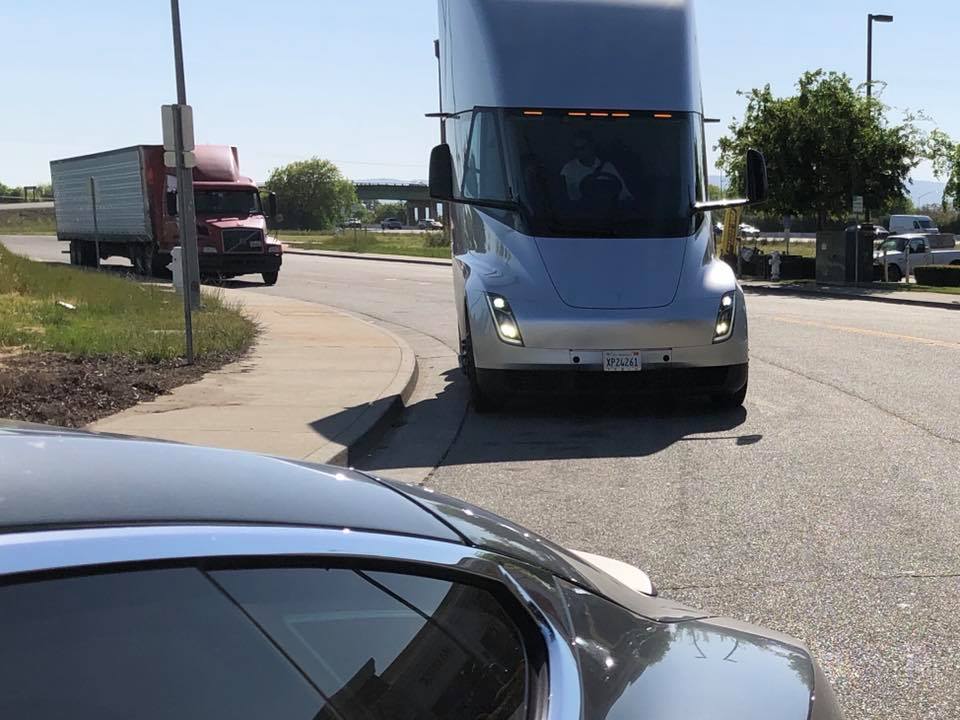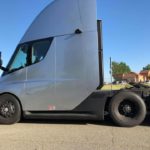

News
Tesla Semi sighted on cargo route between Fremont and Gigafactory
The silver, long-range Tesla Semi electric truck was recently sighted on a cargo route in Dixon, CA, seemingly taking a brief pitstop between the Fremont factory and the Nevada Gigafactory.
The recent Tesla Semi sighting was shared on social media by Model S owner Gytahnna Loffgren, who noted that the electric truck looked great in person. As could be seen in the images provided by Gytahnna, the silver Tesla Semi was spotted on 2715 Plaza Ct, a location close to Rt 80, roughly 83 miles from the Fremont factory. Based on the direction that the truck was facing, the long-hauler appears to have just come off the Rt 80 exit heading north, 177 miles away from the battery factory through I-80 E.
- The Tesla Semi in Dixon, CA. [Credit: Gytahnna Loffgren/Facebook]
- The Tesla Semi in Dixon, CA. [Credit: Gytahnna Loffgren/Facebook]
- The Tesla Semi in Dixon, CA. [Credit: Gytahnna Loffgren/Facebook]
Unlike previous sightings of the electric truck, the Tesla Semi was not pulling any cargo this time around. Considering that it appears to be on its way to Gigafactory 1, there is a good chance that the electric truck, which is equipped with four Model 3-derived electric motors and up to 500 miles of range for the long-range variant, just finished a cargo run to the company’s car factory.
Last March, Tesla CEO Elon Musk revealed on social media that the two prototype Semis would be delivering battery packs from Gigafactory 1 to the Fremont, CA facility. Since then, sightings of the two electric trucks traveling together have increased in frequency, with a recent one even suggesting that the Semis were driving in “Convoy Mode.”
Tesla’s strategy to use the Semi prototypes as part of its delivery fleet for its Nevada and California facilities was explained by VP of Truck programs Jerome Guillen during a talk at the Netherlands.
“Tesla will be the first customer for its own truck. So we will use our own trucks to carry cargo in the US between our different facilities. We have (an) assembly factory in California; we have a battery factory in Nevada, so we’ll use our truck to carry things in between,” he said.
The two Semis’ deployment into the company’s fleet of delivery trucks comes at a time when Tesla is attempting to reach another milestone for its most ambitious vehicle to date — the mass production of the Model 3. Considering that the compact electric sedan’s battery packs are manufactured in Gigafactory 1, the two Tesla Semis are playing a valuable role in helping the company achieve its goal of producing 5,000 Model 3 per week by the end of the second quarter.
Apart from being utilized as delivery vehicles for the Model 3’s batteries, the two Tesla Semi trucks have also been spotted at locations across the United States where some of the vehicles’ customers are based. Over the past few months alone, the Tesla Semi has been sighted in St. Louis, MO at the Anheuser-Busch brewery; in Dallas, TX at a PepsiCo demo event; and at a highway in Des Moines, IA close to the headquarters of Ruan Transportation Management Systems.

News
Tesla starts showing how FSD will change lives in Europe
Local officials tested the system on narrow country roads and were impressed by FSD’s smooth, human-like driving, with some calling the service a game-changer for everyday life in areas that are far from urban centers.

Tesla has launched Europe’s first public shuttle service using Full Self-Driving (Supervised) in the rural Eifelkreis Bitburg-Prüm region of Germany, demonstrating how the technology can restore independence and mobility for people who struggle with limited transport options.
Local officials tested the system on narrow country roads and were impressed by FSD’s smooth, human-like driving, with some calling the service a game-changer for everyday life in areas that are far from urban centers.
Officials see real impact on rural residents
Arzfeld Mayor Johannes Kuhl and District Administrator Andreas Kruppert personally tested the Tesla shuttle service. This allowed them to see just how well FSD navigated winding lanes and rural roads confidently. Kruppert said, “Autonomous driving sounds like science fiction to many, but we simply see here that it works totally well in rural regions too.” Kuhl, for his part, also noted that FSD “feels like a very experienced driver.”
The pilot complements the area’s “Citizen Bus” program, which provides on-demand rides for elderly residents who can no longer drive themselves. Tesla Europe shared a video of a demonstration of the service, highlighting how FSD gives people their freedom back, even in places where public transport is not as prevalent.
What the Ministry for Economic Affairs and Transport says
Rhineland-Palatinate’s Minister Daniela Schmitt supported the project, praising the collaboration that made this “first of its kind in Europe” possible. As per the ministry, the rural rollout for the service shows FSD’s potential beyond major cities, and it delivers tangible benefits like grocery runs, doctor visits, and social connections for isolated residents.
“Reliable and flexible mobility is especially vital in rural areas. With the launch of a shuttle service using self-driving vehicles (FSD supervised) by Tesla in the Eifelkreis Bitburg-Prüm, an innovative pilot project is now getting underway that complements local community bus services. It is the first project of its kind in Europe.
“The result is a real gain for rural mobility: greater accessibility, more flexibility and tangible benefits for everyday life. A strong signal for innovation, cooperation and future-oriented mobility beyond urban centers,” the ministry wrote in a LinkedIn post.
News
Tesla China quietly posts Robotaxi-related job listing
Tesla China is currently seeking a Low Voltage Electrical Engineer to work on circuit board design for the company’s autonomous vehicles.

Tesla has posted a new job listing in Shanghai explicitly tied to its Robotaxi program, fueling speculation that the company is preparing to launch its dedicated autonomous ride-hailing service in China.
As noted in the listing, Tesla China is currently seeking a Low Voltage Electrical Engineer to work on circuit board design for the company’s autonomous vehicles.
Robotaxi-specific role
The listing, which was shared on social media platform X by industry watcher @tslaming, suggested that Tesla China is looking to fill the role urgently. The job listing itself specifically mentions that the person hired for the role will be working on the Low Voltage Hardware team, which would design the circuit boards that would serve as the nervous system of the Robotaxi.
Key tasks for the role, as indicated in the job listing, include collaboration with PCB layout, firmware, mechanical, program management, and validation teams, among other responsibilities. The role is based in Shanghai.
China Robotaxi launch
China represents a massive potential market for robotaxis, with its dense urban centers and supportive policies in select cities. Tesla has limited permission to roll out FSD in the country, though despite this, its vehicles have been hailed as among the best in the market when it comes to autonomous features. So far, at least, it appears that China supports Tesla’s FSD and Robotaxi rollout.
This was hinted at in November, when Tesla brought the Cybercab to the 8th China International Import Expo (CIIE) in Shanghai, marking the first time that the autonomous two-seater was brought to the Asia-Pacific region. The vehicle, despite not having a release date in China, received a significant amount of interest among the event’s attendees.
Elon Musk
Elon Musk and Tesla AI Director share insights after empty driver seat Robotaxi rides
The executives’ unoccupied tests hint at the rapid progress of Tesla’s unsupervised Robotaxi efforts.

Tesla CEO Elon Musk and AI Director Ashok Elluswamy celebrated Christmas Eve by sharing personal experiences with Robotaxi vehicles that had no safety monitor or occupant in the driver’s seat. Musk described the system’s “perfect driving” around Austin, while Elluswamy posted video from the back seat, calling it “an amazing experience.”
The executives’ unoccupied tests hint at the rapid progress of Tesla’s unsupervised Robotaxi efforts.
Elon and Ashok’s firsthand Robotaxi insights
Prior to Musk and the Tesla AI Director’s posts, sightings of unmanned Teslas navigating public roads were widely shared on social media. One such vehicle was spotted in Austin, Texas, which Elon Musk acknowleged by stating that “Testing is underway with no occupants in the car.”
Based on his Christmas Eve post, Musk seemed to have tested an unmanned Tesla himself. “A Tesla with no safety monitor in the car and me sitting in the passenger seat took me all around Austin on Sunday with perfect driving,” Musk wrote in his post.
Elluswamy responded with a 2-minute video showing himself in the rear of an unmanned Tesla. The video featured the vehicle’s empty front seats, as well as its smooth handling through real-world traffic. He captioned his video with the words, “It’s an amazing experience!”
Towards Unsupervised operations
During an xAI Hackathon earlier this month, Elon Musk mentioned that Tesla owed be removing Safety Monitors from its Robotaxis in Austin in just three weeks. “Unsupervised is pretty much solved at this point. So there will be Tesla Robotaxis operating in Austin with no one in them. Not even anyone in the passenger seat in about three weeks,” he said. Musk echoed similar estimates at the 2025 Annual Shareholder Meeting and the Q3 2025 earnings call.
Considering the insights that were posted Musk and Elluswamy, it does appear that Tesla is working hard towards operating its Robotaxis with no safety monitors. This is quite impressive considering that the service was launched just earlier this year.











